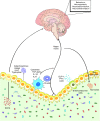May the Force Be With You: The Light and Dark Sides of the Microbiota-Gut-Brain Axis in Neuropsychiatry
- PMID: 27417321
- PMCID: PMC5078156
- DOI: 10.1007/s40263-016-0370-3
May the Force Be With You: The Light and Dark Sides of the Microbiota-Gut-Brain Axis in Neuropsychiatry
Abstract
The role of the gut microbiota in health and disease is becoming increasingly recognized. The microbiota-gut-brain axis is a bi-directional pathway between the brain and the gastrointestinal system. The bacterial commensals in our gut can signal to the brain through a variety of mechanisms, which are slowly being resolved. These include the vagus nerve, immune mediators and microbial metabolites, which influence central processes such as neurotransmission and behaviour. Dysregulation in the composition of the gut microbiota has been identified in several neuropsychiatric disorders, such as autism, schizophrenia and depression. Moreover, preclinical studies suggest that they may be the driving force behind the behavioural abnormalities observed in these conditions. Understanding how bacterial commensals are involved in regulating brain function may lead to novel strategies for development of microbiota-based therapies for these neuropsychiatric disorders.
Conflict of interest statement
Compliance with Ethical Standards Funding Timothy Dinan and John Cryan are supported by the Science Foundation Ireland (SFI) [Grant Numbers 07/CE/B1368 and 12/RC/2273]; the Irish Health Research Board; the Department of Agriculture, Food and the Marine; and Enterprise Ireland. Open Access Fee was funded via the Centre grant to APC Microbiome Institute from Science Foundation Ireland. Conflict of interest Timothy Dinan and John Cryan are in receipt of research funding from 4D-Pharma, Mead Johnson, Suntory Wellness, Nutricia and Cremo. Timothy Dinan has been an invited speaker at meetings organized by Servier, Lundbeck, Janssen and AstraZeneca. John Cryan has been an invited speaker at meetings organized by Mead Johnson, Yakult, Alkermes and Janssen. Eoin Sherwin and Kiran Sandhu have no conflicts of interest to declare.
Figures

References
-
- Dinan TG, Stilling RM, Stanton C, Cryan JF. Collective unconscious: how gut microbes shape human behavior. J Psychiatr Res [Internet]. Elsevier Ltd. 2015;63:1–9. Available from: http://linkinghub.elsevier.com/retrieve/pii/S0022395615000655. - PubMed
Publication types
MeSH terms
LinkOut - more resources
Full Text Sources
Other Literature Sources
Medical

